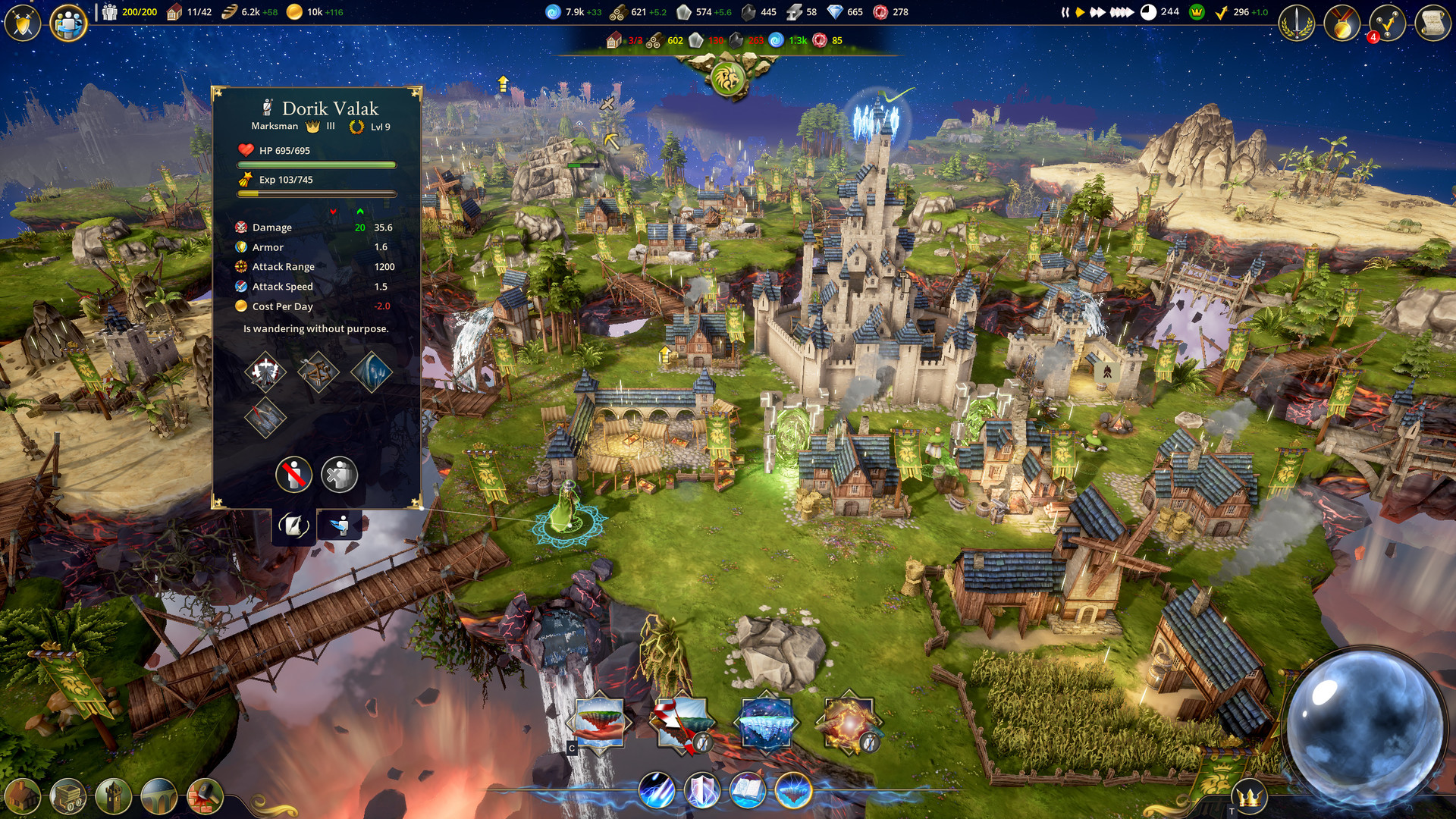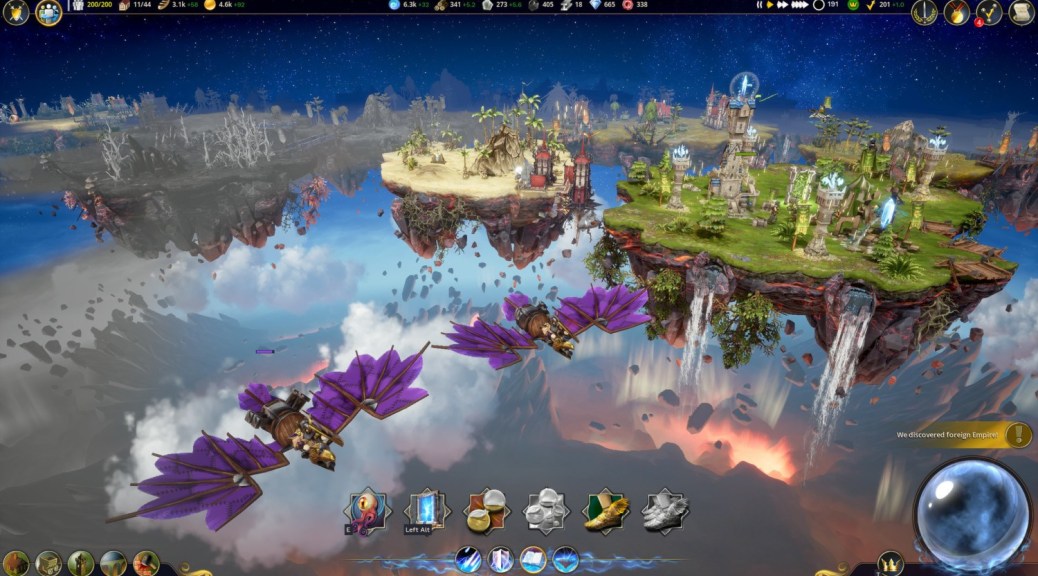Search
[{{{type}}}] {{{reason}}}
{{/data.error.root_cause}}{{{_source.title}}} {{#_source.showPrice}} {{{_source.displayPrice}}} {{/_source.showPrice}}
{{#_source.showLink}} {{/_source.showLink}} {{#_source.showDate}}{{{_source.displayDate}}}
{{/_source.showDate}}{{{_source.description}}}
{{#_source.additionalInfo}}{{#_source.additionalFields}} {{#title}} {{{label}}}: {{{title}}} {{/title}} {{/_source.additionalFields}}
{{/_source.additionalInfo}}Driftland: The Magic Revival (PC)

Driftland: The Magic Revival
Developed By: Star Drifters
Published By: Star Drifters
Released: April 19, 2019
Available On: Windows
Genre: Real-time Strategy
ESRB Rating: (not available)
Number of Players: 1-6 players
Price: $29.99
(Humble Store Link)
Driftland: The Magic Revival is a 2019 real-time strategy (RTS) that attempts to blend elements from various strategy subgenres. The game’s setting of floating islands above a shattered planet will draw immediate comparisons to Netstorm among older players, and to Laputa among readers of Gulliver’s Travels. Throughout the game, you will be commandeering your home island throughout the skies of Driftland, connecting to other islands for precious resources, constructing buildings, researching technology, and raising an army to thwart your enemies.
There are four races to choose from; they play mostly the same in the early game, and their differences only begin to matter towards the late game. You begin with a home island, a Castle, various buildings as dictated by the mission, and then are let loose to build up your empire. You hire an explorer to survey your home island for resources as the first houses and farms are built. Your home island is a tiny plot of land, not nearly enough for your needs. You look around, spy a few nearby floating islands on the minimap, and cast a few spells to scout them, then a few more to bring those islands close enough to build a bridge. They are now part of your empire. More buildings go up, you magically terraform islands as needed, and repeat the process.
Eventually your economy is solid enough to start building a military comprised of heroes. The hero units are controlled indirectly; instead of issuing commands, you issue a bounty of gold against a target, and units will then attack that target if the bounty is big enough to grab their attention. Creating camps allows for much more efficient and cohesive command of your units as they band into small armies. Various spells are also at your disposal to support your heroes as they spread the glory of your thriving empire. This mechanic will draw comparisons to Majesty, which uses an identical setup of indirect control and player-directed spells. Unlike Majesty though, Driftland’s opening phases of play feels like it never ends, and the heavier economic focus only serves to drag down the tactical side of the game.

Strong Points: Relaxing soundtrack
Weak Points: Dichotomous design; combat is difficult to read
Moral Warnings: Fantasy violence; fantasy magic; occult imagery
As mentioned, the game mixes in a few elements from other strategy subgenres. Driftland has almost a dozen resources to be harvested, pushing players to expand their empire prodigiously to find them all, but lacks the deep diplomacy options to properly evoke the 4X branch of strategy. A good proportion of the time spent in a game is just getting your economy functional and figuring out how to get to the next resource, lending it a bit of a city management feel. All this time spent on managing your growing economy just drives home the dichotomous nature of the game. In trying to mix elements from RTS, 4X and city management, it excels at none of them and doesn’t play into any of their strengths. The game pushes the combat as the primary focus of the game, but muddles up this message with the unnecessarily complex economy. It all feels like it really just wants to be an Anno title, with a focus on the economics rather than the military.
Driftland has a token campaign split into four parts, one for each of the game’s races. Each part consists of 5 or 6 missions that detail a multi-factional war that’s been done to death in various other games of this ilk. But instead of continuing the story, each part covers the same timeline of events, serving as a window into what is happening at various points in the story. For the most part, the campaign does not offer anything particularly different; almost all missions play identically to the randomly generated Free Play mode. Each mission took me about 90 minutes to complete, but I’m sure a more proficient player could whittle that down to half or less. There’s also a map editor, for the more creatively inclined people.
There’s also a Nomad Mode which controls somewhat like a very old traditional RTS – so old, in fact, that the controls feel like they were taken from the 1980s. I won’t fault the Nomads Mode too much though, since it’s just a sideshow with a series of scenarios. At the very least, it makes for a bit of variety when the regular empire building gets old.

Higher is better
(10/10 is perfect)
Game Score - 70%
Gameplay - 14/20
Graphics - 7/10
Sound - 7/10
Stability - 3/5
Controls - 4/5
Morality Score - 86%
Violence - 7/10
Language - 10/10
Sexual Content - 10/10
Occult/Supernatural - 6/10
Cultural/Moral/Ethical - 10/10
The aesthetics lend a very relaxing atmosphere to the game. A gentle chorus carries through the soundtrack as your empire expands. There’s none of the pomp or calls to military action as you’d expect from an RTS, making it easy to tunnel vision on your expanding empire and ignore the military arm of the game. Swamps are normally portrayed as landscapes of death and rot; I’ve never seen one look so warm and lively. The dwarf mountains, as barren and blasted as they appear, are offset by its warmer colors. The only significant issue is that some buildings tend to look a bit too similar to each other within the factions, and units are too small to distinguish.
Driftland suffers somewhat in its stability and controls. There were a few times in the campaign where the game just crashed to the desktop; at least the game autosaves every 60 seconds, so I never lost much progress. In the options, opening the controls submenu caused my game to drop down to a mere 6fps until it was closed, making it awkward to try and define new controls. The camera speed slider and Castle-focus hotkey both kept resetting whenever I closed the game. As patient as I am, it was definitely annoying to have to reconfigure things at the start of every session. I should also note that you can plug in a controller and play that way if you really want to, but it’s clearly just an afterthought and not really supported.
Morally, the game is fairly light on concerning content. There’s the violence that’s to be expected from the military side of things. Dead units simply keel over and fade out of existence without any blood, although the flying contraptions of the Dwarves do go down in flames with a small explosion. Language and sexual content are perfectly clean, with nothing anyone could complain about. Magician units are required for a few in-game ritual spells, and the mission briefings for the Dark Elf campaign show candles and various herbs scattered about a desk; both are fairly straightforward allusions to the occult, but their presentation is more in line with fantasy magic. Culturally the game doesn’t present any issues.
As a hodgepodge of strategy subgenres, Driftland is not a perfect execution, but it certainly tries its best. If your favourite part of RTS games is the base building in the first few minutes, Driftland will let you play at that for much of the game, only venturing out once you are ready to completely dominate your opponents. Anyone who remembers Netstorm might also enjoy this game. To everyone else, this is an average but passable game.








